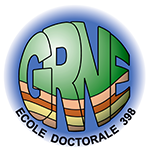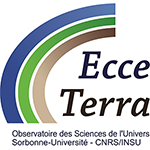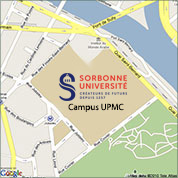Séminaire ISTeP - Ramadan Ghalayini
Rôle de la limite de plaque transformante du Levant sur la structuration cénozoïque du bassin Est-Méditerranéen
Sedimentary basins adjacent to plate boundaries contain key tectonic and stratigraphic elements to understand how stress is transmitted through plates. The Levant basin is a place of choice to study such elements because it flanks the Levant Fracture System and the Africa/Anatolia boundary. New high quality 3D seismic reflection data is used to unravel the tectonic evolution of the margin of this basin during the Cenozoic, the period corresponding to the formation of the Levant Fracture System, part of the Africa/Arabia plate boundary. Four major groups of structures are identified in the interpreted Cenozoic units: NW-SE striking normal faults, NNE-SSW striking thrust-faults, ENE-WSW striking dextral strike-slip faults, and NNE trending anticlines. All structures, apart of the NW-SE striking normal faults, are inherited from Mesozoic faults. Their reactivation and associated folding started during the Late Miocene prior to the Messinian Salinity Crisis due to a NW-SE compressional stress field. No clear evidence of shortening at present day offshore Lebanon and no large NNE-SSW strike-slip faults parallel to the restraining bend are found indicating that the Levant Fracture System is mainly contained onshore at present day. The intermittent activity of the interpreted structures correlates with the two stages of LFS movement during Late Miocene and Pliocene. The seismic interpretation results are validated by analogue modelling of the Levant margin to test the reactivation of pre-existing faults.
21/11/2014 à 12h30, Salle Fourcade (Tour 55/56, 4ème étage)
Egalement dans la rubrique
- Séminaire ISTeP - Chrystèle Sanloup
- Séminaire ISTeP - Marco Scambelluri
- Séminaire ISTeP - Déborah Chavrit
- Séminaire ISTeP - Evgueni Burov
- Séminaire ISTeP - Anne Le Friant
- Séminaire ISTeP - Pierre Valla
- Séminaire ISTeP - Matthias Delescluse
- Séminaire ISTeP - Séverine Moune
- Séminaire ISTeP - Lucie Tajcmanova
- Séminaire ISTeP - Gabriel Coelho
- Séminaire ISTeP - Laurie Bougeois
- Séminaire ISTeP - Jacques Touret
- Séminaire ISTeP - Sanae El Janyani
- Séminaire ISTeP - Arthur Paté
- Séminaire ISTeP - Nicolas Beaudoin
- Séminaire ISTeP - Kosuke Ueda
- Séminaire ISTeP - Ali Hannouche
- Séminaire ISTeP - Benjamin Cochain
- Séminaire ISTeP - Behzad Nasri
- Séminaire ISTeP - Daniel Pastor Galan
- Séminaire ISTeP - Sara Lafuerza Colas
- Séminaire ISTeP - Jean-Pierre Suc
- Séminaire ISTeP - Pierpaolo Zuddas
- Séminaire ISTeP - Agnès Elmaleh
- Séminaire ISTeP - John Wakabayashi
- Séminaire ISTeP - Jonas Ruh
- Séminaire ISTeP - Timm John
Chiffres clés (Mars 2025)
L'ISTeP comprend 131 membres dont :
Permanents (66)
- Professeurs : 17 (+2 PAST)
- Maîtres de conférence : 26
- Directeurs de recherche CNRS : 1
- Chargés de recherche CNRS : 1
- ITA : 19
Personnels non permanents (65)
- Collaborateurs bénévoles / émérites : 17
- Chaire de professeur junior : 1
- Enseignants-chercheurs contractuel : 2
- 1 MCF accueil en délégation
- ATER et Post-Docs : 9
- Doctorants : 32
- ITA-BIATSS : 3





